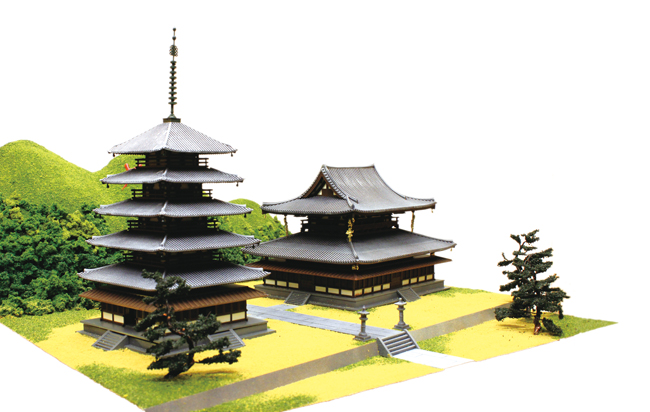
当たり前に日本人として生きてきた。でも海外に出てから、日本について何も知らないことに気が付いた。そこで、日本が世界に誇る世界遺産について建立年順に勉強しようと思う。興味がある人も、そうでない人も、しばしお付き合いを。
I’ve lived my whole life as a Japanese person, but when I went overseas I realised I know practically nothing about Japan. So now I’m learning about Japan’s World Heritage Sites, from oldest to newest. Those who are interested, and even those who are not, come along for the ride.

撮影協力 / メルボルン総領事館 Thanks to the Consulate-General of Japan, Melbourne
○○○○○ 世運隆替の中で絶えることなく息づく信仰の力 法隆寺 ○○○○○
今回は、1993年に日本仏教の歴史上で極めて重要であり、日本の宗教建築に多大な影響を及ぼしたことから世界文化遺産に登録された法隆寺を紹介します。五重塔のあるお寺といえば、殆どの人がピンとくるのでは。世界遺産に登録されている区域は約586ヘクタールあり、法隆寺に属する47棟、法起寺(ほっきじ)に属する1棟を合わせた48棟の建造物群と、その周辺の斑鳩(いかるが)の里と呼ばれる地域です。法隆寺の西院伽藍(さいいんがらん)にいたっては、建築年代に諸説あるものの、世界最古の木造建築として国際的に名が通っています。先月紹介した神を祭る厳島神社と、日本仏教の起源といってもいい法隆寺が共に世界遺産に登録されているところが、神仏が当たり前に共存する日本を表しているのではないでしょうか。
法隆寺は、奈良県生駒郡斑鳩町(いこまぐんいかるがちょう)にある寺院で、仏教を厚く信仰し広めるよう勤めた聖徳太子が創建したと伝えられています。現在は、聖徳太子を宗祖とする聖徳宗(しょうとくしゅう)の総本山となっていて、土地の名から斑鳩寺(いかるがでら)と呼ばれています。ちなみに、斑鳩という町名は鵤(イカル)という鳥の名に由来しているとか。そのため斑鳩町の町章は、鳥がモチーフとなっています。
法隆寺を構成するのは、西院、東院、そして両院の周囲に建てられた子院群で、それぞれ建設された時代が異なるのが特徴です。西院は、607年に建てられたといわれていますが、670年に起きた火災によって焼失し、7世紀後半から8世紀初期にかけて再建されました。以前は、この再建説を巡って激しい論争が起こったのですが、最近の研究から再建説が定説となっています。西院の主要建築である、金堂、五重塔、中門、回廊は、仏教の伝来元である中国や朝鮮にも残っていない初期の仏教建築様式で、世界的に貴重な物。1300年以上もの時を経て、当時の姿を現在に伝えているのは、宮大工(みやだいく)と呼ばれる神社仏閣の建築や補修に携わる大工達の努力があってこそ。かつては日本全国に数百人いた宮大工ですが、現在では継承者は100人以下と言われています。厳しい世界だけになかなか継承者が育たないのは分かるのですが、寂しいですね…。
東院は、8世紀前半に行信僧都という高僧が、聖徳太子の遺徳を偲んで建設しました。東院の主要建築は、八角円堂の夢殿で、聖徳太子の等身像とされる救世観音像を安置しています。この八角の円堂スタイルは、中国易経の八方位陰陽説から来ているといわれています。どうりで中国映画に出てきそうな佇まいだと思った。更に、両院の周囲にある子院は12世紀頃に建築が始まり、17世紀から18世紀にかけて数を増やしていきました。そうしたことから、日本の仏教寺院建築の変遷を一気に見ることのできる場所です。
法隆寺には、貴重な仏像や壁画が多く残されています。一時は寺の維持そのものが困難となり、一部の宝物が皇室に謙譲されましたが、それでも現在、国宝や重要文化財に指定された物(建築物も含む)は約190件、点数にして2,300点に及び、まさに仏教文化の宝庫となっています。
次回は、古都奈良の文化財のひとつ薬師寺を紹介します。
○○○Horyu-ji: the strength of unwavering faith through the vicissitudes of fortune○○○
This time I introduce Horyu-ji, a temple added to the World Heritage list in 1993 due to its importance in the history of Japanese Buddhism and its great influence on religious architecture in Japan. If I say ‘the temple with the five-storey pagoda,’ you might know the one I mean. The World Heritage protected area is around 586 hectares, including 48 structures belonging to Horyu-ji Temple, one structure belonging to Hakki-ji Temple, and land belonging to the village of Ikaruga. There are several theories concerning when the Horyu-in West Temple (Sai-in) was constructed, but it is said to be the oldest wooden building in the world. Itsukushima Jinja, the shinto shrine introduced last month, and Horyu-ji, perhaps the origin of Japanese Buddhism, were registered together to the World Heritage List; together they express the way that Shinto and Buddhism are practised side-by-side in Japan.
Horyu-ji is a temple in the town of Ikaruga, in Ikoma District, Nara Prefecture. Horyu-ji was built by devout Buddhist Prince Shotoku who did much work to spread the religion in Japan. Today it is the headquarters of the Shotoku Sect, founded by Prince Shotoku; due to its location, it is sometimes called Ikaruga Temple. Incidentally, the town’s name ‘Ikaruga’ is derived from a bird called the ‘ikaru’, which is why the town’s logo features a bird.
Horyu-ji is made up of Sai-in (in the west) and To-in (in the east), along with sub-temples surrounding each. Notably, different parts were built in different eras. Sai-in was built in the year 607, but was probably destroyed by a fire in 670 and rebuilt from the late 7th century to the early 8th century. In the past, there was an intense controversy over whether the temple had been reconstructed, but recent research has led to this theory being widely accepted. Sai-in’s main structures – the ‘kondo’ (sanctuary hall), five-storey pagoda, central gate and cloisters – are of international significance, as they are in an early Buddhist architectural style that has disappeared even from Korea and China, where Buddhism originated. The fact that these structures have survived 1300 years is due to the efforts of ‘miyadaiku’, carpenters who specialise in constructing and repairing shrines and temples. Once there were miyadaiku all over Japan, but today fewer than 100 remain. I realise it must be hard to find a successor for so exacting a trade, but how lonely for the miyadaiku...
To-in was built in the first part of the 8th century by a high priest called Gyoshin, as a tribute to the memory of Prince Shotoku. One of the main structures of To-in is the octagonal Yumedono (Hall of Dreams), in which is enshrined the Guse-Kannon, a Buddhist statue said to have been modelled after Prince Shotoku. This octagonal style is likely derived from the eight trigrams of the Chinese I Ching, so it’s no wonder the Yumedono looks like it could be something out of a Chinese film. Furthermore, sub-temples began to be constructed around To-in and Sai-in in the 12th century and more in the 17th and 18th centuries. This makes Horyu-ji a place where one can see at one time the many changes in Japanese Buddhist architecture.
In addition to the World Heritage-listed structures, Horyu-ji also contains many precious Buddhist statues and murals; for a while, when there were difficulties preserving the temple, some of the treasures were donated to the Imperial Household. But today Horyu-ji still contains around 2300 precious historical artifacts, of which 190 (including buildings) have been designated as National Treasures or Important Cultural Properties. Horyu-ji really is a treasury of Buddhist culture.
Next time, I introduce a temple called Yakushi-ji in Nara Prefecture.

